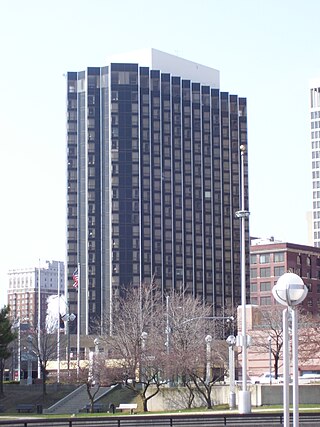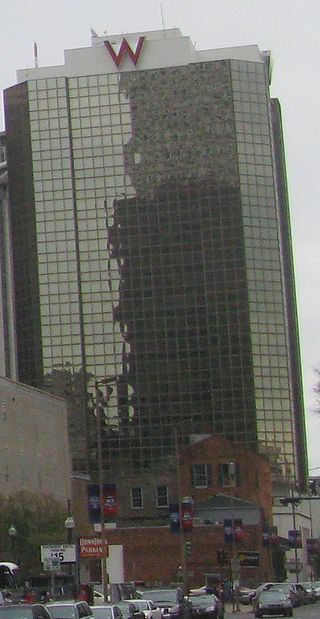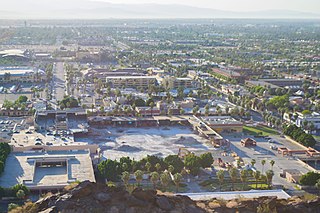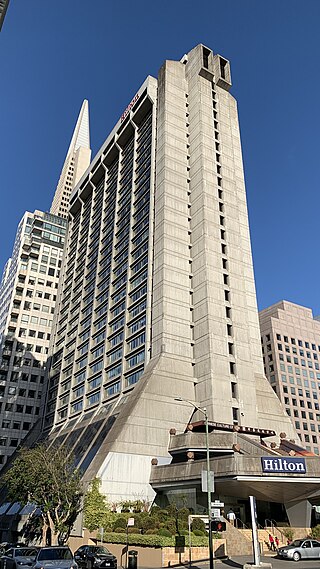
Ortigas Center is a central business district located within the joint boundaries of Pasig, Mandaluyong and Quezon City, within the Metro Manila region in the Philippines. With an area of more than 100 hectares, it is Metro Manila's second most important business district after the (Makati CBD). It is governed by Ortigas Center Association, Inc.

The Florida Mall is a super regional enclosed shopping mall located south of Orlando in unincorporated Orange County, Florida, United States, on the southeast corner of Orange Blossom Trail and Sand Lake Road; it opened in 1986. The mall features JCPenney, Dillard's, Macy's, Dick's Sporting Goods, and Sears, in addition to the Crayola Experience.
Holiday Inn is an American chain of hotels based in Atlanta, Georgia and a brand of IHG Hotels & Resorts. The chain was founded in 1952 by Kemmons Wilson, who opened the first location in Memphis, Tennessee. The chain was a division of Bass Brewery from 1988-2000, Six Continents from 2000-03, and IHG Hotels & Resorts since 2003. It operates hotels under the names Holiday Inn, Holiday Inn Express, Holiday Inn Club Vacations, and Holiday Inn Resorts. As of 2018, Holiday Inn has hotels at over 1,100 locations.

Trost & Trost Architects & Engineers, often known as Trost & Trost, was an architectural firm based in El Paso, Texas. The firm's chief designer was Henry Charles Trost, who was born in Toledo, Ohio, in 1860. Trost moved from Chicago to Tucson, Arizona in 1899 and to El Paso in 1903. He partnered with Robert Rust to form Trost & Rust. Rust died in 1905 and later that year Trost formed the firm of Trost & Trost with his twin brother Gustavus Adolphus Trost, also an architect, who had joined the firm as a structural engineer. Between 1903 and Henry Trost's death on September 19, 1933, the firm designed hundreds of buildings in the El Paso area and in other Southwestern cities, including Albuquerque, Phoenix, Tucson, and San Angelo.

Chandler Fashion Center is a regional shopping center located in the city of Chandler, Arizona, and is the second largest mall in the Phoenix metropolitan area. The mall is owned by Macerich and was developed by Westcor a former subsidiary of Macerich. The mall features Dillard's, Scheels, Macy's as well as a Harkins Theatres. The mall is located on the northwest corner of the AZ Loop 101 (Price) and AZ Loop 202 (SanTan) but can also be accessed from Chandler Boulevard. Chandler Fashion Center serves as a transit center for Valley Metro Bus.

Myron Hubbard Hunt was an American architect whose numerous projects include many noted landmarks in Southern California and Evanston, Illinois. Hunt was elected a Fellow in the American Institute of Architects in 1908.

The Fort Pontchartrain a Wyndham Hotel, is a 367-room, 25-story high-rise hotel opened in 1965, adjacent to TCF Center in Downtown Detroit, Michigan.

The Sheraton Fallsview is a 22-story hotel located within Falls Avenue Resort in Niagara Falls, Ontario, Canada.

Le Méridien New Orleans is a 23-story high-rise building in the Central Business District of New Orleans, Louisiana. The building rises 279 feet, and is currently tied with Charity Hospital as the 29th-tallest building in the city. It also stands as the 8th-tallest hotel in New Orleans.

The Alamo Plaza Historic District is an historic district of downtown San Antonio in the U.S. state of Texas. It was listed on the National Register of Historic Places in 1977. It includes the Alamo, which is a separately listed Registered Historic Place and a U.S. National Historic Landmark.

The Crowne Plaza Times Square Manhattan is a hotel at 1601 Broadway, between 48th and 49th Streets, in the Theater District of Midtown Manhattan in New York City. The hotel is operated by third-party franchisee Highgate and is part of the Intercontinental Hotels Group's Crowne Plaza chain. It has 795 guest rooms.

The Hotel Majestic St. Louis in St. Louis, Missouri, United States is a restored 91-room historic hotel built in 1913–1914. It is listed on the National Register of Historic Places in 1984.

Desert Fashion Plaza, formerly known as Desert Inn Fashion Plaza, was an enclosed shopping mall located in Palm Springs, California. The mall was originally developed by Home Savings and Loan Association, which sold the shopping center to Desert Plaza Partnership.

The Crowne Plaza Christchurch, formerly known as the Forsyth Barr Building, is located on the south-east corner of the Armagh and Colombo Streets intersection in Christchurch, New Zealand. Originally owned by Bob Jones and branded Robert Jones House by him, it was commonly referred to as Bob Jones Tower, but some called it Bob's Folly. In the 2011 Christchurch earthquake, its staircases collapsed, trapping the occupants. The building reopened in July 2017 as the city's Crowne Plaza hotel.

The Crowne Plaza in Christchurch, New Zealand, originally known as the Parkroyal Hotel, was a hotel of the Crowne Plaza group. Built in 1988 in the north-west corner of Victoria Square after much public protest, as it cut off the first part of Victoria Street, its construction happened at the same time and enabled the substantial redesign of Victoria Square. The building had New Zealand's largest atrium, and was one of the city's largest hotels. The building suffered significant damage in the 2011 Christchurch earthquake and was demolished in April 2012. The Crowne Plaza group has secured a lease in the Forsyth Barr Building at the opposite end of Victoria Square.

Arthur Burnett Benton was an American architect. Benton promoted Mission Revival architecture.

Historic Hotels of America is a program of the National Trust for Historic Preservation that was founded in 1989 with 32 charter members; the program accepts nominations and identifies hotels in the United States that have maintained their authenticity, sense of place, and architectural integrity.

The Hilton San Francisco Financial District is a skyscraper hotel located east across Kearny Street from Portsmouth Square on the border between the Financial District and Chinatown neighborhoods of San Francisco, California. It opened in 1971 on the site formerly occupied by the San Francisco Hall of Justice, which had served as the headquarters of the San Francisco Police Department until 1961. The Chinese Culture Center leases approximately 20,000 sq ft (1,900 m2) within the building for rotating exhibitions at a nominal cost due to lobbying from the local Chinese-American community.























